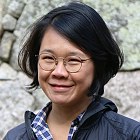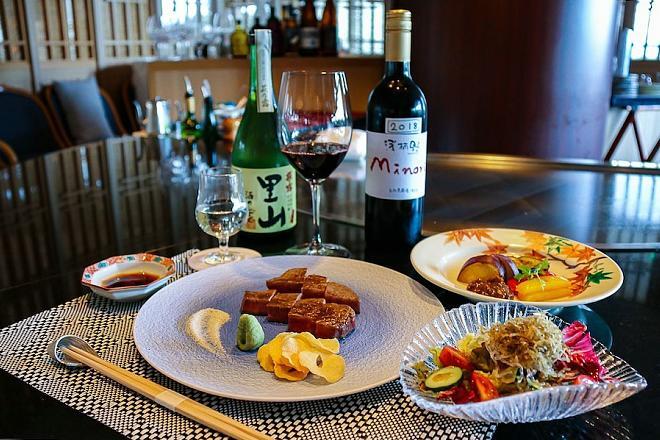Traditional experiences: Buddhist cuisine and knife making
Religion and traditional craft make up an important part of Japanese culture and heritage, and these can be seen in festivals celebrated countrywide and at places of worship. Traditional skills and religious rites and practices have been passed down for generations, and parts of these have become ingrained in Japanese customs and everyday life. On this trip, I visited Koyasan in Wakayama Prefecture, a sacred mountain and one of the centers of Buddhism in Japan, and Sakai in Osaka Prefecture, a major producer of Japanese knives and the birthplace of Sen no Rikyu, the grandmaster of tea.
My two-day trip began in central Osaka from where I took the train to Koyasan to learn more about Buddhist cuisine, visit the religious sites on the mountain and stay overnight at a temple. The following day was spent in Sakai where I had lunch at a tea shop, visited a blacksmith's forge and ended the day at a sake bar in the city.

Day 1
Buddhism is one of the major religions in Japan, and Shingon Buddhism, which was introduced to Japan by Kobo Daishi in 806, is one of the largest Buddhist sects in Japan. Kobo Daishi established the headquarters of Shingon Buddhism on Koyasan over 1200 years ago, and since its founding, Koyasan has received many monks who wish to train in the teachings of Kobo Daishi and pilgrims who journey over mountains to pay their respects to the venerable teacher.
As the center of Shingon Buddhism, the headquarters of the sect as well as numerous other subtemples are located on Koyasan, along with one of the largest cemeteries in Japan. Kobo Daishi himself, is said to be in eternal meditation in his mausoleum on the mountain.
A number of pilgrimage routes span the mountain, and of interest is the Choishi-michi route which starts at Jison-in Temple near Kudoyama Station at the base of Koyasan. The almost 25 kilometer trail has been used by pilgrims since the establishment of Shingon Buddhism on Koyasan, and offers a view that has remained almost unchanged over the centuries.
The Choishi-michi gets its name from the stone markers which can be seen along the route. Each marker is erected about one cho, a unit of distance which measures 109 meters, from one another. There are 180 stone markers between Jison-in Temple at one end of the route and Konpon Daito Pagoda at the other end in the temple town, and another 36 markers that lead to Kobo Daishi's mausoleum in Okunoin.





My visit to Koyasan started at Koyasan Station on the top of the mountain from where I took a bus into the center of the temple town. I walked through the temple town towards Okunoin, a vast cemetery and location of Kobo Daishi's mausoleum. Along the way, I could not resist stopping at a couple of traditional Japanese shops.
The first was Kasakuni, a confectionery store which has nourished weary pilgrims and travelers for over a century. The store sells a variety of Japanese confectionery and is a popular place for visitors to buy edible souvenirs. The second store I visited was Hamadaya, a well-known sesame tofu maker. Sesame tofu is a typical dish in Buddhist cuisine, and at Hamadaya, the simple dish is made with only three ingredients: sesame, water and kudzu root.









Next on my walk was Shojoshin-in Temple, located right beside the traditional entrance to Okunoin. Here, I had the opportunity to participate in a gomataki fire ritual, which involved writing my wishes on a wooden stick and having it burnt in a sacred fire in front of the Fudo Myoo Buddhist deity. This ritual is held at Shojoshin-in Temple once a day and everyone is welcome to join. The fire ritual is one which is meant to take away our troubles and cleanse us, while also supplicating our requests and wishes to the heavens through the Fudo Myoo Buddhist deity. I found this to be quite an experience, seeing the large sacred fire before me and being surrounded by the resonating chants of the devotees and temple priests present.


After that fire ritual, I headed out and into Okunoin. There are three bridges that one crosses in Okunoin before reaching Kobo Daishi's mausoleum, and Ichinohashi, the first bridge, marks the traditional entrance to the vast cemetery. The approach from Ichinohashi to the mausoleum is about two kilometers one way and takes about 30 to 45 minutes to walk at a leisurely pace. Once inside, surrounded by old, tall trees and tombstones, I could feel myself getting more relaxed with each step I took further into the serene cemetery.




I could have easily spent a few hours inside the cemetery, but it was time to head on to my temple accommodation for the night before it got dark. Staying at a shukubo or temple lodging is one of the draws for many who visit Koyasan. Many of the temples on the mountain offer simple accommodation, which allow visitors to experience a part of temple life through eating vegetarian Buddhist cuisine, participating in temple activities like morning prayers and sutra copying.
My shukubo for the night was Rengejo-in Temple, which has beautiful painted fusuma sliding doors in the rooms and raked stone gardens. The temple monk showed me around the temple and introduced some of the activities available there. Dinner, which was Buddhist cuisine or shojin ryori, was served around 18:00. Buddhist cuisine is completely plant-based and made without animal products. My dinner had an assortment of dishes cooked in various ways - raw, steamed, boiled, simmered, fried and grilled. The seasonal ingredients were enhanced by their methods of cooking as well as the addition of condiments like flavored salt, sesame seeds and miso. I found all the dishes to be very satisfying and flavorful, and wished that I could have shojin ryori more often.
Bedtime is pretty early when staying at a shukubo, mostly because a monk's day starts when the sun rises. I tucked myself into bed a few hours after dinner, grateful for a delicious meal and comfortable bedding to sleep in.








Day 2
Morning prayers are part of the morning rituals when staying at a shukubo, and while they are not compulsory, they are highly recommended to get a complete temple lodging experience. The prayers typically last for about 20 to 30 minutes, followed by a short lecture by the chief priest. Five minutes before the morning prayers began, a bell was rung to signal the time to gather by the main hall of the temple. I joined the morning prayers and found it to be a good time to practice a bit of mindfulness at the start of the day.
Breakfast followed the morning prayers, and it was yet another delicious vegetarian meal. I checked out of my shukubo not long after breakfast, and made my way back to Koyasan Station and down the mountain to Sakai where I would start the second part of my trip.


Sakai in southern Osaka is a well-known knife producing area in Japan and the birthplace of tea master Sen no Rikyu, who is credited to be the founder of the tea ceremony most widely practiced today. My visit to Sakai began at Tsuboichi Seicha Honpo, a local tea specialist since the mid 19th century. Not only does Tsuboichi sell tea leaves and tea paraphernalia, it also has a cafe section where visitors can enjoy quality tea, sweets and light meals.
I settled myself in the cafe area and ordered a tea lunch set, which came with a selection of small dishes flavored with tea leaves. The star of the meal for me, however, was the bowl of rice porridge cooked in roasted green tea and topped with a pickled plum. The flavor combination of tea, sour plum and rice was one I did not expect would go so well together.




Sakai is a well-known knife making region in Japan and has about 500 years of history forging blades the traditional way. After lunch, I made my way to Sasuke, a local blacksmith forge, to learn more about this traditional craft. Established in 1867, Sasuke is one of the few in the industry that specializes in garden shears and scissors, but also includes kitchen knives in its repertoire. Hirakawa-san, the current blacksmith at Sasuke, is the fifth generation blacksmith.
I went on a forge tour at Sasuke, and it started with an explanation of the material used to make kitchen knives as well as the different types of knives made at the forge. Next, I had the opportunity to see master blacksmith Hirakawa-san at work as he made a kitchen knife. Each blade is hand forged with a precision only an experienced artisan can achieve, and it was just unbelievable watching the master at work.
The last part of the tour was a hands-on session in which I could try out some knives and scissors. I was blown away by the edge on the knives; each cut and slice was so smooth. Honestly, I was a little afraid to put my fingers too close to the blade. Trying out the scissors was another jaw-dropping experience. The two blades on the scissors connect only at a single point each time and cut so beautifully regardless of handedness. Needless to say, I was just in awe at the skills of the master and the art of forging blades. I left Sasuke filled with admiration and a renewed determination to hone my knife skills.




To round up my visit to Sakai, I headed to a sake bar near Sakaihigashi Station, from where I would take the train back to central Osaka. It was a pleasant place to sample some regional sake paired with small bites, and a nice way to bring my overnight trip to a leisurely close.


Access
Central Osaka (Namba Station) can be accessed from Kansai International Airport (KIX) by direct trains on Nankai Railway.
How to get to and around Koyasan from Osaka
Take the Nankai Koya Line from Namba Station, the terminal station in central Osaka, to Gokurakubashi Station, the terminus of the line. Express trains require a transfer at Hashimoto Station, while limited express trains provide a direct connection between Namba and Gokurakubashi. At Gokurakubashi Station, change to the Koyasan cable car to get to Koyasan Station, from where frequently departing buses connect to the temple town.
The "Koyasan-World Heritage Ticket" offered by Nankai Railway is an economical pass for those making visiting Koyasan from central Osaka. The pass, which is valid for two days, includes a return journey to Koyasan from central Osaka, unlimited use of the buses on Koyasan for two days and discounted admission to the major sightseeing spots on Koyasan. The pass can be purchased at Nankai Namba Station and other major Nankai Electric Railway stations.
Buses departing from Koyasan Station provide access to the town of Koyasan. Senjuinbashi is the central bus stop in the temple town, and the major sightseeing spots are within walking distance from there.
Approximate walking times
- Senjuinbashi to Ichinohashi: 10 minutes
- Ichinohashi to Gobyobashi: 20 minutes
- Senjuinbashi to Rengejo-in Temple: 15 minutes

How to get to and around Sakai from Koyasan
Take the Koyasan cable car down the mountain to Gokurakubashi Station, and from there change to the Nankai Koya Line to Sakaihigashi Station, one of the main stations serving Sakai City. Express trains require a transfer at Hashimoto Station, while limited express trains provide a direct connection between the two stations.
From Sakaihigashi Station, it is a 20 minute walk to Tsuboichi Seicha Honpo, and from there, a 15 minute walk to Sasuke, the blacksmith forge.



